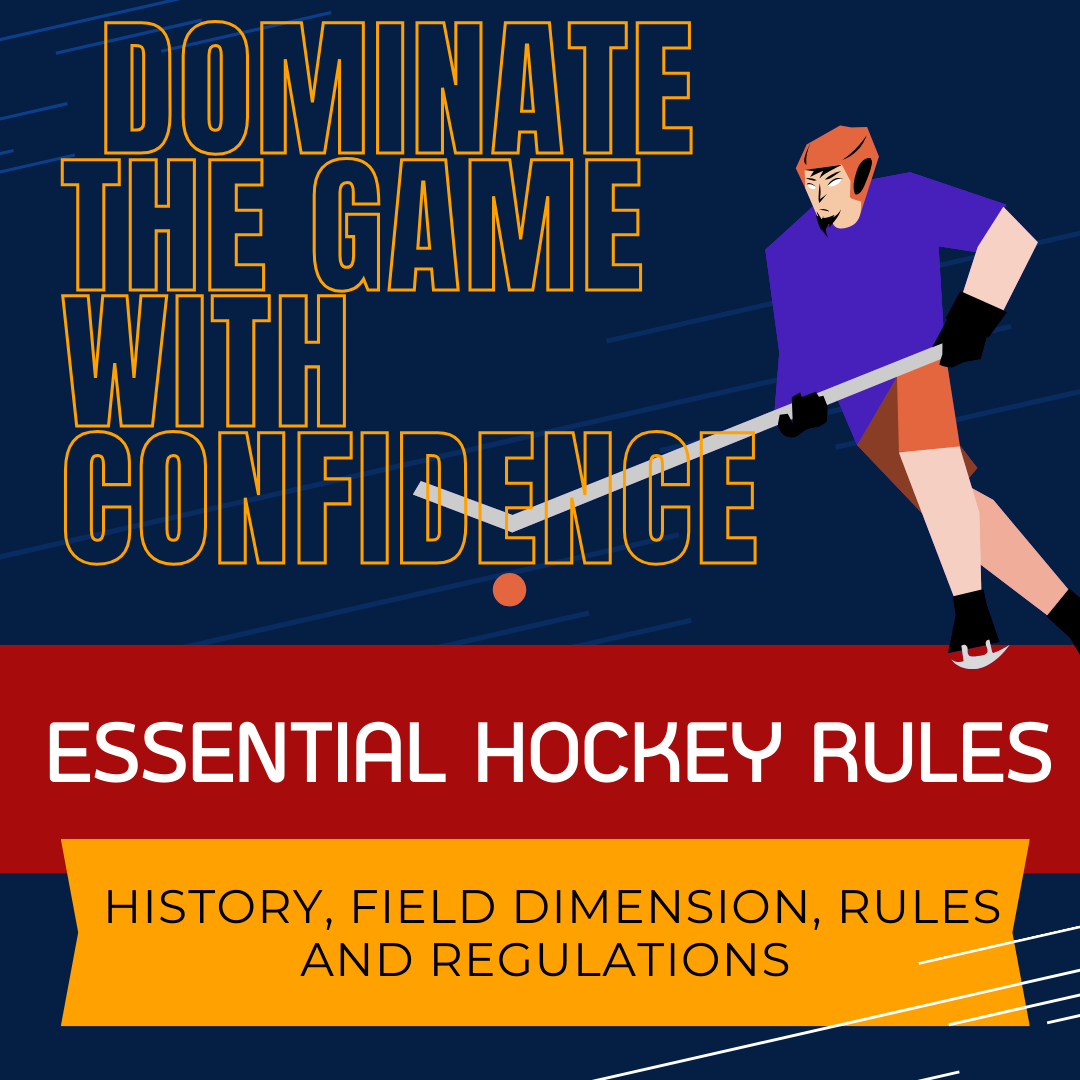Hockey: History, Field dimension, Rules and Regulations
Hockey is a dynamic and fast-paced team sport played on various surfaces, most commonly ice, field, or street. The objective of the game is simple: to score more goals than the opposing team by getting a puck or ball into their net using a stick. The sport is renowned for its blend of speed, skill, and physicality, making it thrilling to play and watch. Let’s dive into the fascinating journey of hockey, its governing bodies, rules and regulations, major tournaments, and the legends who have left an indelible mark on the sport.
The History of Hockey
Ancient Origins
Hockey’s roots are deeply embedded in antiquity. It is believed that a crude form of the game was played in Egypt approximately 4,000 years ago. In Ethiopia, the game was also played around 1,000 BC. Additionally, an ancient version was played in Iran around 2,000 BC.
Modern Development
The modern game of hockey was shaped in England during the mid-18th century. Several key milestones mark its development:
- In 1875, the modern form of hockey was initiated.
- The English Hockey Association was established at the Cannon Street Hotel in London in 1876.
- The earliest clubs were founded, including Blackheath Hockey Club in 1861 and Teddington Hockey Club in 1871.
- The rules of the game were formulated by the Wimbledon Hockey Club in 1883, and these rules were later recognized by the Hockey Association in 1886.
- In 1887, the first women’s hockey club, East Molesey Club, was established in England.
- The first international match was played on January 26, 1895, between Wales and Ireland in Rhyl, England.
International Recognition
The global expansion of hockey was facilitated by the formation of international governing bodies:
- The Federation International de Hockey (FIH) was established on January 7, 1924, in Brussels, Belgium, and its headquarters are now located in Lausanne, Switzerland.
- The International Federation of Women’s Hockey Associations (IFWHA) was founded in 1927 to govern women’s hockey internationally.
Hockey Field Measurements
Field Dimensions
- Length: The standard length of a field hockey pitch is set at 100 yards (91.4 meters).
- Width: The width of the pitch is specified as 60 yards (55 meters).
- Surface: The playing surface can be composed of grass, artificial turf, or water-based turf.
Goal Dimensions
- Width: The goal is designed to be 12 feet (3.66 meters) wide.
- Height: The goal is constructed to be 7 feet (2.14 meters) high.
- Depth: The goal’s depth is set at 4 feet (1.22 meters) at ground level and 3 feet (0.91 meters) at crossbar level.
Markings on the Field
- Center Line: A line is drawn across the width of the field at the halfway mark.
- 23-Meter Lines: Two lines are marked across the width of the field, 23 meters (25 yards) from each end line.
- Shooting Circle (D): A semicircular line is marked 16 yards (14.63 meters) from the goal line, defining the shooting circle from which goals must be scored.
- Penalty Spot: Located 7 yards (6.4 meters) from the goal line, this spot is used for taking penalty strokes.
- Corner Markings: Quarter circles with a radius of 1 yard (0.91 meters) are marked at each corner of the field for penalty corners.
Areas on the Field
- Shooting Circle: This area extends 16 yards from each goal post, forming a semicircle where most offensive and defensive actions are conducted.
- Penalty Corner: Awarded for certain infractions within the shooting circle, a penalty corner is taken from the corner mark.
- Penalty Stroke Line: This line, located 7 yards from the goal, is where penalty strokes are taken.
Substitution Area
- Location: The substitution area is positioned on the sideline, near the center of the field.
- Dimensions: It extends 5 yards (4.57 meters) on either side of the center line.
Summary
- Field Length: Set at 100 yards (91.4 meters)
- Field Width: Specified as 60 yards (55 meters)
- Goal Width: Designed to be 12 feet (3.66 meters)
- Goal Height: Constructed to be 7 feet (2.14 meters)
- Shooting Circle Radius: Marked at 16 yards (14.63 meters)
- Penalty Spot Distance: Set at 7 yards (6.4 meters)
- 23-Meter Line Distance: Marked 23 meters (25 yards) from each end line
Hockey Stick and ball-
Hockey Stick:
- Length: Generally ranges from 36.5 inches to 38 inches (92.7 cm to 96.5 cm). However, junior sticks for younger players can be shorter.
- Weight: Typically between 12 oz to 26 oz (340 g to 737 g).
- Shape: The stick has a curved hook at the end, which varies in depth and shape depending on player preference and playing position (e.g., attackers may prefer a more curved hook for better control).
Hockey Ball:
- Diameter: The standard field hockey ball has a diameter of about 2.5 inches (6.35 cm).
- Weight: Typically between 5.5 oz to 5.75 oz (156 g to 163 g).
These dimensions ensure that the equipment meets international regulations for field hockey, but it’s worth noting that slight variations might exist depending on regional or league rules.
Hockey Rules and Regulations:
Gameplay Basics
Objective: The primary objective in hockey is to score goals by hitting the ball into the opponent’s net using a hockey stick.
Teams: Each team typically consists of 11 players, including a goalkeeper. Players are divided into forwards, midfielders, defenders, and the goalkeeper, each with specific roles and responsibilities.
Duration: A standard game consists of two halves, usually 35 minutes each at the international level, with a 5-10 minute halftime break.
Start of Play: The game begins with a coin toss followed by a center pass. Teams alternate possession after goals are scored or when a violation occurs.
Key Rules and Regulations
Stick and Ball: Players must use a hockey stick to pass, dribble, and shoot the ball. The stick must be held below shoulder height and cannot be used in a dangerous or reckless manner that endangers other players.
Goal Scoring: A goal is scored when the entire ball crosses the goal line between the goalposts and under the crossbar. Goals are worth one point.
Penalties: Penalties are enforced for infractions such as dangerous play, obstruction, and improper tackling. Penalties can result in free hits, penalty corners, or penalty strokes depending on the severity of the offense.
Free Hits: Awarded for fouls outside the shooting circle, free hits allow the opposing team to restart play without pressure from the attacking team.
Penalty Corners: Awarded for defensive fouls inside the shooting circle, penalty corners are a significant scoring opportunity. The ball is placed on a spot, and attackers attempt to score against defenders and the goalkeeper.
Offsides: Hockey does not have a strict offside rule like soccer. Players can move freely across the field without restrictions on their positioning relative to the ball and opponents.
Substitutions: Players can be substituted freely throughout the game, typically during breaks in play or by notifying the officials.
Fouls in Hockey
In field hockey, fouls and penalties are an integral part of maintaining fair play and ensuring player safety. Here’s a detailed look at the types of fouls, the disciplinary actions (cards) associated with them, and the role of officials in enforcing these rules:
Type of Foul-
- Dangerous Play: Actions that endanger the safety of players, such as high sticks, dangerous tackles, or reckless challenges.
- Obstruction: Blocking an opponent’s path to the ball or impeding their progress without attempting to play the ball.
- Backsticks: Using the rounded side of the stick to hit or control the ball, which is not allowed.
- Body Contact: Illegal physical contact between players, such as pushing, charging, or tripping.
- Breaking: Violating specific rules regarding the placement and movement of players during set plays, such as free hits or penalty corners.
- Other Fouls: Including dissent (arguing with officials), time-wasting, or deliberately delaying the game.
Cards in Hockey
Field hockey uses a card system to penalize players for fouls, with each color representing a different severity:
- Green Card: A caution for minor offenses, typically for a first-time offense or persistent minor infringements. The player must leave the field temporarily (usually 2 minutes) but can return after the penalty expires.
- Yellow Card: A more serious penalty for repeated minor offenses or a single moderate offense (like dangerous play). The player is sent off for a longer period (usually 5 minutes) and cannot be replaced during this time, leaving their team short-handed.
- Red Card: The most severe penalty, typically given for serious offenses such as violent conduct, deliberate dangerous play, or dissent after a yellow card. A red card results in immediate expulsion from the game, and the player’s team must play short-handed for the remainder of the match.
Officials
Officials, including umpires and a video umpire in high-level matches, are responsible for enforcing the rules of the game and ensuring fair play:
- Umpires: Two umpires control the game from the field, each responsible for one half of the field. They enforce the rules, award penalties, and manage game flow.
- Video Umpire: In international and high-level matches, a video umpire assists with reviewing contentious decisions, such as penalty strokes or goal decisions, using video replay technology.
- Role: Officials uphold the integrity of the game by ensuring that players adhere to the rules, providing a safe environment, and making critical decisions that impact the outcome of the match.
Understanding hockey rules and regulations enhances both players’ enjoyment and spectators’ appreciation of the sport. By familiarizing yourself with these fundamental aspects, you gain insight into the strategy, tactics, and excitement that define hockey at every level of play. Whether you’re watching a local match or cheering for your national team in a global tournament, the rules of hockey serve as the framework for this dynamic and captivating sport.
Download PDF- Hockey Rules
Watch All game video on youtube.
Test your knowledge with additional quizzes here.



